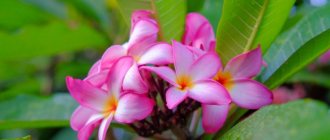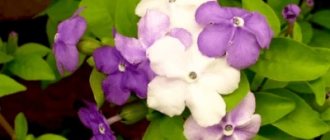Another one that arrived in our homes from the tropics is the homemade mimosa bashful. It attracts flower growers with its unusual properties. This very fragile and delicate gift of nature will not leave you indifferent. In this article you will learn a lot of interesting and useful information about mimosa pudica and its cultivation at home. You will become savvy and ready to successfully grow it in your home.
- Description of mimosa bashful
- Reproduction of mimosa pudica at home
- Pollinating mimosa flowers at home
- Propagation of mimosa by seeds
- Propagation of mimosa by cuttings
- Mimosa care at home
- Negative factors when growing mimosa pudica
Photo: Mimosa pudica on the windowsill.
Mimosa pudica - what kind of flower is it?
A delicate flower brought to Europe from the tropical regions of Latin America is a perennial herbaceous plant from the genus Mimosa of the Legume family. The impossibility of growing mimosa shyus in the natural conditions of mid-latitudes has made it a popular flower for the home or greenhouse.
What does a bashful mimosa look like?
When kept at home, the blooming prude grows no more than 50-60 cm in height. In nature, this subshrub grows 2-2.5 times taller. The straight trunk with small thorns makes it look like a miniature tree. All parts of the plant are covered with a delicate hairy outer layer.
The long cuttings of the branches are decorated with groups of small bipinnate sensitive leaves, because of which the plant actually received the name Mimosa pudica. Sensitive foliage reacts to light, darkness, air movement and the slightest touch. Small pink-purple spherical flowers eventually turn into pods, each of which contains 8-10 seeds.
Shy impatiens folds its leaves from the wind, light and hand touch
For your information! A tender plant tends to smell and drop its leaves not only because of external irritants. An exotic flower, obeying the biological cycle, does this every 22 hours.
Due to the peculiarities of its care, the plant is considered capricious. Neglecting maintenance rules can lead to the death of the plant in the cold season. And then, to make up for the loss, gardeners have to grow a new plant from seeds.
General information
Where does mimosa pudica grow?
On the Black Sea coast, the plant can reach 12 m in height in the form of a bush. Most often it can be found in the Caucasus, Abkhazia and Sochi. Previously, growing mimosa was only possible as a shrub in parks. Now it is so widespread that it grows on its own and no longer surprises anyone.
Interesting! In addition to Russia, mimosa is grown in Madagascar, Montenegro and France, on the coasts of Brazil and America.
Description of mimosa bush
Despite the variety of plant varieties, there is a general description that unites them:
- The crown consists of brown shoots with small cracks.
- The plant has a thorny trunk and small dissected leaves.
- Depending on the growing region, the first mimosa flowers may appear in mid-January.
- Mimosa flowers look like fluffy yellow balls.
Important! Flowering can cause inconvenience to allergy sufferers; you should be aware of this and do not grow such a plant at home.
Features of mimosa leaves
Every time you touch the foliage of the plant, it curls up, but after some time it regains its previous appearance.
This reaction also appears with the arrival of evening, especially if the temperature changes. If you shake a mimosa bush, it takes on a withered appearance, which also goes away over time.
Growing mimosa pudica from seeds at home
Despite the fact that mimosa, called impatiens, is a perennial plant, at home it is most often grown as an annual. This is due to the fact that some novice flower lovers cannot provide proper care and satisfactory conditions.
Mimosa Hostilis - what kind of plant?
For mimosa shy, the following can be detrimental:
- low temperature;
- presence of drafts;
- lack of sunlight or artificial lighting;
- excess moisture in the soil;
- low air humidity, heat.
Important! In addition to these factors, the healthy development of a plant can be affected by: tobacco smoke, disease or insect pests.
Reviews from gardeners
Elena, Italy
She is African, which means that in winter she most likely needs 15 degrees, for me now it drops below 10 at night, although it is quite warm during the day.
Source: forum-flower.ru
Elena Orlova
Take the seeds and put them on a towel, cover with the same towel (I take a kitchen waffle) and pour boiling water from the kettle. 80-85 degrees, immediately remove from the towel and sow in the ground, my germination rate is 100%.
Source: otvet.mail.ru
How to care for impatiens at home
Mimosa - what kind of flower is it, what does it look like
Caring for mimosa pudica at home will not require much effort if the requirements for temperature and light conditions are met. In addition, the plant reacts sensitively to watering, spraying and fertilizing with mineral fertilizers.
Indoor Mimosa Pudica reacts painfully to everything
Note! Lack of sufficient experience and skills in growing exotic plants can lead indoor mimosa to loss of decorativeness, disease or complete death. A positive result is possible only if the rules of agricultural technology are observed.
Illumination and temperature conditions
In order for the plant to feel comfortable, bloom long and profusely, it needs good lighting. It is best to place the flowerpot on the windowsills on the south side of the house.
In winter, in the absence of sufficient light, the shy mimosa will require additional lighting. Artificial lighting should provide the plant with at least 10-12 hours of daylight.
Important! Insufficient lighting negatively affects the decorative appearance of the plant: it stretches out or even loses its foliage. Despite the fact that the sissy loves an abundance of sunlight, in the summer heat it should be slightly shaded, otherwise direct sunlight can cause burns. This is especially true for weak plants or young seedlings grown from seeds.
Artificial lighting mimosa
In addition, growing a tropical plant requires strict adherence to temperature conditions. The ideal air temperature for normal seedling growth ranges from 20-24 °C.
In the cold season, when the plant is dormant, the optimal ambient temperature should be between 16-18 °C. Changes or sharp drops in temperature will negatively affect the health of indoor flowers.
Note! Seedlings that require a tropical climate react negatively to heat and dry air. Therefore, it is extremely undesirable to place mimosa in a flower pot near heating radiators or heating devices.
Failure to comply with temperature and light conditions in winter leads to the fact that in the spring the exotic flower will look unattractive. The stems, weakened by lack of light and heat, will become too elongated and their color will become pale green.
Watering rules and humidity
Accustomed to tropical humidity, pink mimosa at home requires abundant watering. This is especially true during the hot season. In the summer heat, when the air temperature exceeds 24-26 °C, it is necessary to periodically spray the seedling. Lack of moisture and low humidity can affect the beauty of the plant: its foliage will turn yellow or begin to fall off rapidly.
For your information! In climatic conditions where day and night air temperatures are not subject to sudden changes, the flower can be placed in the summer on a balcony or in the courtyard of a private house. The main conditions for such a temporary “relocation” are timely watering and periodic spraying.
In winter, the plant does not require frequent watering, as it is at rest. A decrease in air temperature and excess moisture in the soil can cause irreparable harm. The root system will begin to rot, and the seedling will eventually disappear.
Fertilizing and soil quality
In order for the bashful plant to acquire the necessary decorative effect, it requires fertile soil, which can be purchased at a specialized store. It is also possible to prepare the soil yourself. To do this, just mix in equal proportions:
- peat;
- chopped tree bark;
- washed quartz sand;
- perlite
In addition to the fact that the bottom of the flower pot must have a hole, it must be lined with a small layer of charcoal or expanded clay. This will ensure good drainage and protect the root system from excess moisture, which causes rot and fungal diseases.
Important! Garden soil should never be added to the soil mixture. The tropical plant requires loose soil, and soil from the garden plot can compact it.
To maintain the soil in an ideal condition for impatiens, it is necessary to systematically apply organic and mineral fertilizers during the growing season and active growth. The frequency of fertilizing should be at least 2 times a month using the dosage indicated on the drug.
Healthy flowering plant after fertilizing
The optimal period for fertilizing is from early spring to mid-autumn. After the plant has flowered and entered a dormant state, the use of fertilizers should be stopped.
Flower container size
For normal vegetation and crown development, mimosa does not need a large flowerpot. This is due to the fact that the plant does not have a very developed root system. Planting in a larger container is carried out only in the case of planting young seedlings in a permanent place.
Pruning and replanting
Deviations from the rules of agricultural technology and unsatisfactory living conditions can lead to the capricious sissy quickly losing its decorative appearance:
- the foliage will turn pale green;
- the trunk will stretch out greatly;
- leaves turn yellow or fall off;
- the plant will not bloom or stop blooming.
To remedy this situation, flower lovers use intensive pruning or pinching. In this way a beautiful crown is formed.
In exceptional cases, when the plant has overwintered satisfactorily, it can be transplanted into another container. This process is carried out exclusively by transshipment, so as not to damage the roots. To do this, the earthen lump in the flower pot must be slightly dried so that it does not fall apart during the replanting process.
Features of plant flowering
Gardenia in bloom - what an indoor and outdoor plant looks like
Growing indoor mimosa is not as difficult as achieving abundant flowering. The plant reacts sensitively to the slightest conditions of maintenance and care. Therefore, it requires attention and care not only during the formation of flower buds, but throughout the year.
Period of activity and rest
The active phase of plant development and growth is limited to the period between mid-spring and late autumn. During this period, the bashful beauty requires abundant watering, spraying and systematic feeding with fertilizers.
During the dormant period, the plant should be watered only when the top layer of soil in the pot dries. Low room humidity can be compensated with a cup of water placed next to the flower pot. Any kind of fertilizing in winter is categorically excluded.
Types and shape of flowers
Botanists have studied and described more than 600 species of mimosa. The most common in the European part of the continent are 3 types:
- bashful mimosa. Its pink-lilac flowers are collected in the shape of a ball and consist of four parts;
- rough (lat. Mimosa Scabrella). The flowers are collected in lush panicles of bright yellow color;
- lazy (lat. Mimosa Pigra). The spherical inflorescences are white.
Blooming Mimosa Scabrella
Most species known to science are perennial shrubs and are widely used for decorative planting.
Flower propagation methods
The high demands on light, heat and moisture mean that not every exotic lover will agree to care for such a fastidious exotic all year round. It is much easier to grow a new seedling with the onset of spring. That is why mimosa pudica is most often used indoors as an annual plant.
Reproduction by cuttings
Trying to decorate their home with an exotic sissy, some gardeners are attempting to propagate it by cuttings. To do this, a cutting of a branch at least 20 cm long must be kept for 2-3 hours in a solution of root or potassium humate.
The cuttings prepared in this way are planted in moist, loose soil.
Note! Planting material can be covered with a large plastic cup or glass jar. The microclimate formed under the hood will give a greater chance that the first roots will appear in 2 weeks.
Propagation by seeds
In order for an unusual flower to settle forever in the collection of house plants, avid flower growers try to plant it with seeds every spring. This method of reproduction is considered the most effective because it gives good results.
Young shoots from seeds
It is enough to plant a seed in a moistened substance in early or mid-March and cover it with a small layer of soil. The planting container should be covered with polyethylene or a piece of glass, placing it in a warm place. In 2-3 weeks the first shoots will appear.
Beneficial features
“Touch-me-not” is known for its beneficial properties. It has long been used in many European countries in medicine. Non-traditional methods of treatment are not complete without the use of the healing properties of this plant.
- Tincture from the leaves treats sore throat and reduces fever.
- A decoction of the bark – dysentery and headache.
- Ointments treat burns and heal wounds.
- Mimosa preparations purify the blood.
- Helps in treating the heart and nervous system.
- The liver and gallbladder are tidied up.
Growing problems, diseases and pests
Mimosa, accustomed to a tropical climate, requires special conditions and careful care. The key threat that prevents indoor pets from growing and enjoying a healthy appearance is harmful insects. These small, sometimes barely noticeable pests can cause irreparable damage to a home flower.
How to deal with them
Damage to indoor plants by harmful insects most often occurs due to improper care of them. Usually they are started in cases of violation of thermal, light and water regimes. Lack of light and overly wet soil are an excellent environment for their reproduction.
Insecticides such as phytosporin or actara are used to control pests. The same means can be used as a preventive measure if pests appeared earlier on a plant adjacent to the mimosa. To prevent this nuisance, you should periodically inspect the crown of your home flowers.
Aphids are a serious pest of indoor plants.
Beautiful and capricious impatiens, requiring special attention, can decorate any home, office or greenhouse. To do this, you should carefully follow the step-by-step recommendations of specialists. The gratitude of a well-groomed plant will be expressed in an attractive appearance and abundant flowering.











